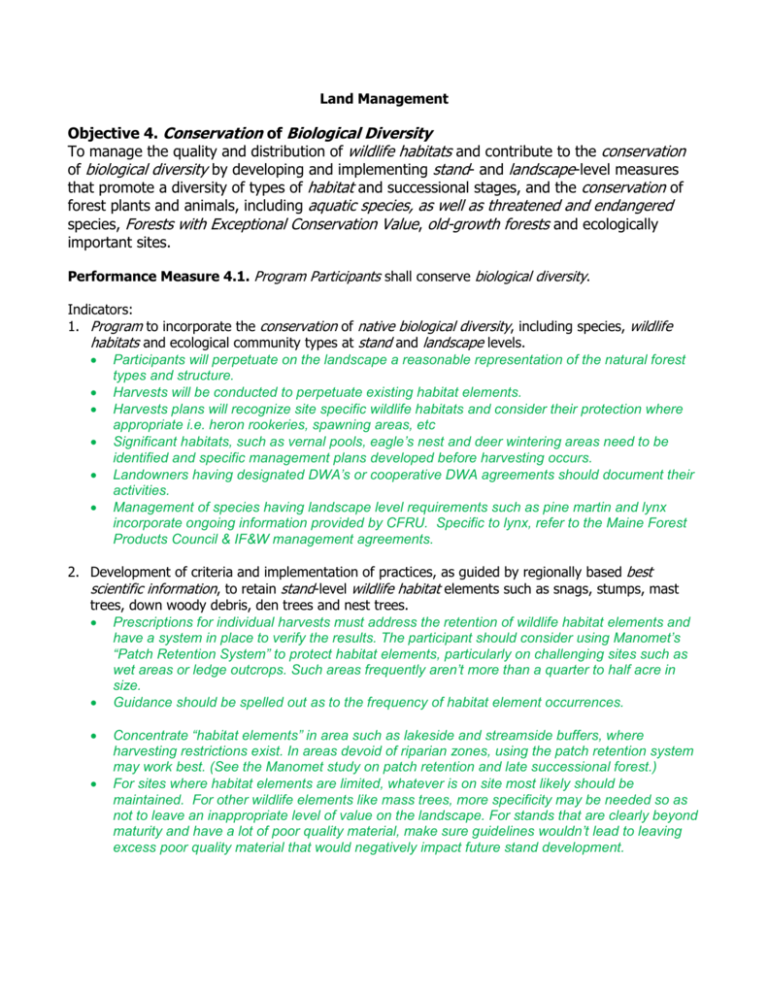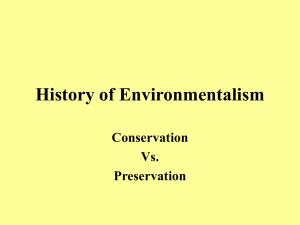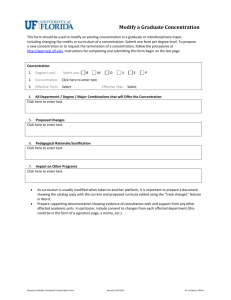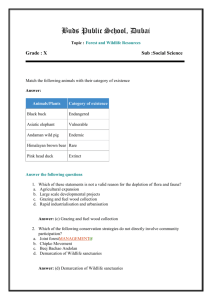Objective-4-LM - Maine Forest Products Council
advertisement

Land Management Objective 4. Conservation of Biological Diversity To manage the quality and distribution of wildlife habitats and contribute to the conservation of biological diversity by developing and implementing stand- and landscape-level measures that promote a diversity of types of habitat and successional stages, and the conservation of forest plants and animals, including aquatic species, as well as threatened and endangered species, Forests with Exceptional Conservation Value, old-growth forests and ecologically important sites. Performance Measure 4.1. Program Participants shall conserve biological diversity. Indicators: 1. Program to incorporate the conservation of native biological diversity, including species, wildlife habitats and ecological community types at stand and landscape levels. Participants will perpetuate on the landscape a reasonable representation of the natural forest types and structure. Harvests will be conducted to perpetuate existing habitat elements. Harvests plans will recognize site specific wildlife habitats and consider their protection where appropriate i.e. heron rookeries, spawning areas, etc Significant habitats, such as vernal pools, eagle’s nest and deer wintering areas need to be identified and specific management plans developed before harvesting occurs. Landowners having designated DWA’s or cooperative DWA agreements should document their activities. Management of species having landscape level requirements such as pine martin and lynx incorporate ongoing information provided by CFRU. Specific to lynx, refer to the Maine Forest Products Council & IF&W management agreements. 2. Development of criteria and implementation of practices, as guided by regionally based best scientific information, to retain stand-level wildlife habitat elements such as snags, stumps, mast trees, down woody debris, den trees and nest trees. Prescriptions for individual harvests must address the retention of wildlife habitat elements and have a system in place to verify the results. The participant should consider using Manomet’s “Patch Retention System” to protect habitat elements, particularly on challenging sites such as wet areas or ledge outcrops. Such areas frequently aren’t more than a quarter to half acre in size. Guidance should be spelled out as to the frequency of habitat element occurrences. Concentrate “habitat elements” in area such as lakeside and streamside buffers, where harvesting restrictions exist. In areas devoid of riparian zones, using the patch retention system may work best. (See the Manomet study on patch retention and late successional forest.) For sites where habitat elements are limited, whatever is on site most likely should be maintained. For other wildlife elements like mass trees, more specificity may be needed so as not to leave an inappropriate level of value on the landscape. For stands that are clearly beyond maturity and have a lot of poor quality material, make sure guidelines wouldn’t lead to leaving excess poor quality material that would negatively impact future stand development. 3. Document diversity of forest cover types and age or size classes at the individual ownership or forest tenure level, and where credible data are available, at the landscape scale. Working individually or collaboratively to support diversity of native forest cover types and age or size classes that enhance biological diversity at the landscape scale. A participant, on their own lands, will develop a timeframe for obtaining information on its forest for cover types, habitats, forest structure and age. (Note: There is a way cover types can be used to determine how well the habitat needs of different species are being met. This methodology is fairly complex to use and would likely require expert assistance.) If of interest to the Maine Forest Service, the participant will consider providing non proprietary information or information aggregated with other landowners, in order to enhance understanding of regional and landscape scale forest conditions for planning and management purposes. 4. Program Participants shall participate in or incorporate the results of state, provincial, or regional conservation planning and priority-setting efforts to conserve biological diversity and consider these efforts in forest management planning. Examples of credible priority-setting efforts include state wildlife action plans, state forest action plans, relevant habitat conservation plans or provincial wildlife recovery plans. ME’s SIC Wildlife Subcommittee is represented in the ME Wildlife Action Plan committee and steering committee. ME’s SIC is a primary sponsor of the Fisheries Improvement Network. PPs supporting the MFPC, CFRU or SBW task force directly are in support of the SBW taskforce. PP’s in Downeast Maine participating in Project Share. Or other similar initiatives. Document management consideration derived from landscape conservation efforts previously mentioned. 5. Program to address conservation of known sites with viable occurrences of significant species of concern. Confer and MNAP and IF&W. Hire a forest ecologist to survey your land, if you have the resources. 6. Identification and protection of non-forested wetlands, including bogs, fens and marshes, and vernal pools of ecological significance. Restricting operations to either dry periods or the winter, use of single grip harvesters, returning slash to skid trails are options to consider. For vernal pools indicate you will follow BMPs. Operations wouldn’t take place in a fen. Refer statewide standards and ME BMP for water quality. 7. Participation in programs and demonstration of activities as appropriate to limit the introduction, spread and impact of invasive exotic plants and animals that directly threaten or are likely to threaten native plant and animal communities. On an annual basis, updates will be sought from appropriate sources including DIF&W, DEP, and DOC’s Natural Areas program and Forest Health and Monitoring Division on invasive species that could negatively impact native species and communities. These contacts must be documented. Such updates will include inquiries on; o Currently known locations, o Recent publications and o Management guidelines Participants will commit to periodic training on key invasive species. Participants will commit to adhering to quarantines and document compliance. Any evidence of invasive species on participants land base will be reported to the appropriate agencies. 8. Consider the role of natural disturbances, including the use of prescribed or natural fire where appropriate, and forest health threats in relation to biological diversity when developing forest management plans. This indicator is probably not applicable on the participant’s land base. (The management of fire associated species such as white pine and poplar can be accomplished through other methodologies such as mechanical site preparation.) Performance Measure 4.2. Program Participants shall protect threatened and endangered species, Forests with Exceptional Conservation Values (FECV) and old-growth forests. Indicators: 1. Program to protect threatened and endangered species. The participant’s program will include a query of MNAP and IF&W information for the location and management strategies for endangered species located on their land base. Participants will receive periodic training on endangered species and G1 and G2 species. 2. Program to locate and protect known sites flora and fauna associated with viable occurrences of critically imperiled and imperiled species and communities also known as Forests with Exceptional Conservation Value. Plans for protection may be developed independently or collaboratively, and may include Program Participant management, cooperation with other stakeholders, or use of easements, conservation land sales, exchanges, or other conservation strategies. Participants will establish plans to protect identified Forest of Exceptional Conservation Value (where G1 & G2 communities are present) through such mechanisms as; land swaps, conservation easements and land sales. 3. Support of and participation in plans or programs for the conservation of old-growth forests in the region of ownership or forest tenure. Should have evidence of collaboration with Public Lands, or conservation groups such as TNC on their measures to preserve old growth forest. For participants that have old growth forest, you may consider land swaps, land sales or conservation easements. Performance Measure 4.3. Program Participants shall manage ecologically important sites in a manner that takes into account their unique qualities. Indicators: 1. Use of information such as existing natural heritage data or expert advice in identifying or selecting ecologically important sites for protection. Implement plans outlined in indicator 4.2.3 2. Appropriate mapping, cataloging and management of identified ecologically important sites. Implement plans outlined in indicator 4.2.3 Performance Measure 4.4. Program Participants shall apply knowledge gained through research, science, technology and field experience to manage wildlife habitat and contribute to the conservation of biological diversity. Indicators: 1. Collection of information on Forests with Exceptional Conservation Value and other biodiversityrelated data through forest inventory processes, mapping or participation in external programs, such as NatureServe, state or provincial heritage programs, or other credible systems. Such participation may include providing non-proprietary scientific information, time and assistance by staff, or in-kind or direct financial support. Participants may allow such groups as ME’s Natural Areas Program to inventory their lands for non proprietary type information in order to identify forest of exceptional conservation value and other biodiversity related data. Forest inventories conducted by participants may incorporate information targeting potential forest of exceptional value and biodiversity specific information as is practical. 2. A methodology to incorporate research results and field applications of biodiversity and ecosystem research into forest management decisions. Participants will periodically review studies completed by organizations such as Manomet and CFRU for information that they can incorporate into their forest management activities to enhance biodiversity and ecosystem health (Using Manomet’s “Patch Retention and Late Successional guidelines would be examples.) Suggested Documentation: Document programs developed under this objective. Document Participant’s criteria for selecting habitat elements (How many mass trees?) Manomet and CFRU studies on late successional forests. “Biodiversity in the Working Forest” publication, “Threatened and Endangered Species In Forests of Maine” publication. Guidelines for managing vernal pools (DIF&W document) Documented training for participant’s staff on identification, location and management of specific species, habitats and communities and such as; vernal pools, DWAs, Eagles nest, endangered species, Martin & Lynx…. Documentation of commitments to participate with others on conservation of: o Old growth forest o Limitation of invasive exotic species o Collection of information on forest of exceptional conservation value and other biodiversity related data. Training needs: Biodiversity training. The State Implementation Committee has a module called, “Balancing Wildlife Needs and Forest Products” including information on vernal pools, deer wintering areas, biomass retention guidelines and T&E. Manomet and CFRU can put on training to cover anything from vernal pools, patch retention to identifying and managing for late successional trees.







